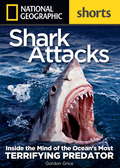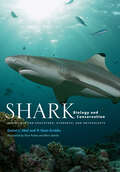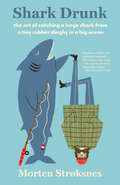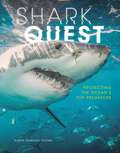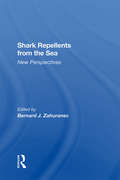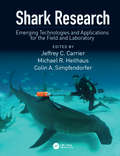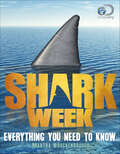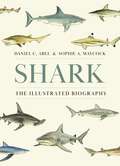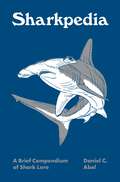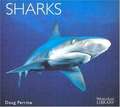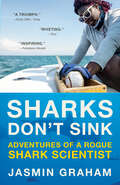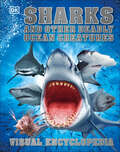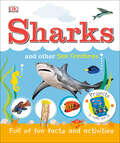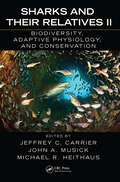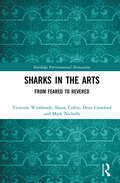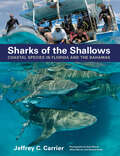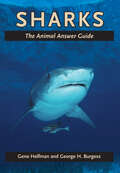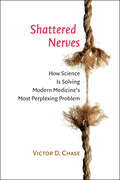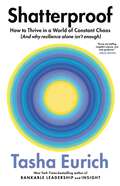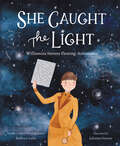- Table View
- List View
Shark Attack!
by Cathy East DubowskiSavage killers or angered victims? Shark Attack tells readers the truth about the most feared creatures in the sea while exploring the anatomy of the shark and touching on different breeds including tiger sharks, bull sharks and the most feared in the sea -- the great white.
Shark Attack!
by Cathy East Dubowski"Shark Attack!" is an exciting and educational exploration of the world of sharks. This book provides fascinating facts about various shark species, their habitats, behaviors, and their role in the ocean ecosystem. It delves into their hunting techniques, unique adaptations, and the myths surrounding these incredible predators. Designed for young readers, the book combines stunning visuals with engaging narratives to make learning fun and interactive. It also emphasizes the importance of shark conservation and debunks common misconceptions. Perfect for budding marine biologists, it offers a deeper appreciation for these misunderstood creatures and their critical role in maintaining oceanic balance.
Shark Attacks: Inside the Mind of the Ocean's Most Terrifying Predator
by Gordon GriceSharks are the world's most fascinating predators - capable of detecting a single drop of blood in 25 million drops of ocean and sensing electricity emitted by their prey. This ebook short takes readers deep into the realm of the very latest shark science, including new insights into the nature of shark attacks around the world.
Shark Biology and Conservation: Essentials for Educators, Students, and Enthusiasts
by Daniel C. Abel R. Dean GrubbsFeed your fascination with sharks! This complete resource enlightens readers on the biology, ecology, and behavior of sharks with approachable explanations and more than 250 stunning color illustrations.Studies of shark biology have flourished over the last several decades. An explosion of new research methods is leading to a fascinating era of oceanic discovery. Shark Biology and Conservation is an up-to-date, comprehensive overview of the diversity, evolution, ecology, behavior, physiology, anatomy, and conservation of sharks. Written in a style that is detailed but not intimidating by world-renowned shark specialists Dan Abel and Dean Grubbs, it relays numerous stories and insights from their exciting experiences in the field. While explaining scientific concepts in terms that non-specialists and students can understand, Abel and Grubbs reveal secrets that will illuminate even the experts. The text provides readers with a robust and wide range of essential knowledge as it• introduces emerging as well as traditional techniques for classifying sharks, understanding their behavior, and unraveling the mysteries of their evolution;• draws on both established shark science and the latest breakthroughs in the field, from molecular approaches to tracking technologies;• highlights the often-neglected yet fascinating subject of shark physiology, including heart function, sensory biology, digestion, metabolic performance, and reproduction;• addresses big picture ecological questions like "Which habitats do sharks prefer?" and "Where do sharks migrate and for what purpose?";• describes the astonishing diversity of sharks' adaptations to their environment;• discusses which shark conservation techniques do and don't work; and• comments on the use and misuse of science in the study of sharks.Enhanced by hundreds of original color photographs and beautifully detailed line drawings, Shark Biology and Conservation will appeal to anyone who is spellbound by this wondrous, ecologically important, and threatened group, including marine biologists, wildlife educators, students, and shark enthusiasts.
Shark Drunk: The Art of Catching a Large Shark from a Tiny Rubber Dinghy in a Big Ocean
by Morten StroksnesA salty story of friendship, adventure, and the explosive life that teems beneath the ocean, for readers of Bill Bryson and such classics as The Snow Leopard. In the great depths surrounding the Lofoten islands in Norway lives the infamous Greenland shark. At twenty-six feet in length and weighing more than a ton, it is truly a beast to behold. But the shark is not just known for its size alone: its meat contains a toxin that, when consumed, has been known to make people drunk and hallucinatory. <P><P>Shark Drunk is the true story of two friends, the author and the eccentric artist Hugo Aasjord, as they embark on a wild pursuit of the famed creature--from a tiny rubber boat. Together, the two men tackle existential questions, survive the world's most powerful maelstrom, and, yes, get drunk, as they attempt to understand the ocean from every possible angle, drawing on poetry, science, history, ecology, mythology, and their own, sometimes intoxicated, observations. <P><P>Winner of the Norwegian Brage Prize 2015 <P><P>Winner of the Norwegian Critics’ Prize for Literature 2015 <P><P>Winner of the Norwegian Reine Ord Prize at Lofoten International Literature Festival 2016
Shark Lady: True Adventures of Eugenie Clark
by Ruth Chew Ann McgovernA biography of the ichthyologist whose interest in fish began at the age of nine during weekly trips to the Aquarium in New York City. Copyright © Libri GmbH. All rights reserved.
Shark Quest: Protecting the Ocean's Top Predators
by Karen Romano YoungSharks are in trouble. Fifty shark species are at high risk of extinction, and another sixty-three are threatened. These intelligent, mysterious—and sometimes scary—fish evolved about 420 million years ago. They have adapted to survive deep in the ocean and in shallow-water habitats. Commercial fishing and finning are threatening shark populations. So is water pollution. Marine biologists and others, including young people, are working together to save these fascinating predators. Discover the work of scientists and conservationists as they study shark biology and morphology; research migration, feeding, and mating patterns; delve into human, climate, and other threats to shark habitat; and develop sophisticated technologies to aid sharks and shark research. See how scientists also educate the public about real and imagined fear of sharks and encourage citizen participation in shark conservation efforts. Learn about high-tech tagging for tracking shark migration paths. Discover the autonomous underwater vehicles and drones that divers use to observe and photograph sharks up close. Visit shark sanctuaries in the South Pacific Ocean. You'll even meet the Shark Lady, a.k.a. Eugenie Clark, a pioneer ichthyologist (shark scientist). Through research and advocacy, people around the world are working to protect—and admire—sharks. "[A]n engaging, well-researched book about a much maligned species of fish that deserves our protection."—Booklist "A remarkably thorough tour of the world of sharks and marine scientists' efforts to educate the public about our ocean's apex predators."—Kirkus Reviews
Shark Repellents From The Sea: New Perspectives
by Bernard J ZahuranecSome species of sharks, because they are large, agile predators, are extremely dangerous to humans in water. During World War II, the long-time goal of an effective shark repellent was partially realized by the U.S. Navy's development of "Shark Chaser," a copper acetate-negrosine dye mixture. But neither Shark Chaser nor other noxious or even extre
Shark Research: Emerging Technologies and Applications for the Field and Laboratory (CRC Marine Biology Series)
by Jeffrey C. Carrier, Michael R. Heithaus and Colin A. SimpfendorferOver the last decade, the study of shark biology has benefited from the development, refinement, and rapid expansion of novel techniques and advances in technology. These have given new insight into the fields of shark genetics, feeding, foraging, bioenergetics, imaging, age and growth, movement, migration, habitat preference, and habitat use. This pioneering book, written by experts in shark biology, examines technologies such as autonomous vehicle tracking, underwater video approaches, molecular genetics techniques, and accelerometry, among many others. Each detailed chapter offers new insights and promises for future studies of elasmobranch biology, provides an overview of appropriate uses of each technique, and can be readily extended to other aquatic fish and marine mammals and reptiles. Including chapter authors who were pioneers in developing some of the technologies discussed in the book, this book serves as the first single-source reference with in-depth coverage of techniques appropriate for the laboratory and field study of sharks, skates, and rays. It concludes with a unique section on Citizen Science and its application to studies of shark biology. This is a must-read for any marine biologist or scientist working in the field of shark biology, as well as marine biology students and graduates.
Shark Week: Everything You Need to Know
by Martha BrockenbroughGliding through the water at breakneck speeds--a fin, just skimming the surface of the water. The biggest jaws you've ever seen. These are the iconic images that flash through all our minds when we think of sharks, but there's so much more to know about these majestic predators of the sea.If you're already a fan of the Discovery's phenomenon Shark Week, then you will love this book! From the unique look of the prehistoric Whorl shark, to the hunting techniques of the Great White, all the thrills and chills of Shark Week are now here for year-round reading. Filled with photos, first-hand accounts of shark attacks, and unbelievable facts (Did you know that there are sharks that live in volcanoes?), this book is for every shark fanatic who wants to get even more up close and personal.Now you really can live every week like it's shark week.
Shark!
by Jerrill ParhamNIMAC-sourced textbook. Advisory: Bookshare has learned that this book offers only partial accessibility. We have kept it in the collection because it is useful for some of our members. To explore further access options with us, please contact us through the Book Quality link on the right sidebar. Benetech is actively working on projects to improve accessibility issues such as these.
Shark: The Illustrated Biography
by Daniel Abel Sophie A. MaycockA marvelously illustrated look at the life of the sharkNo two species of shark have the same life history, yet these magnificent creatures share many things in common. This one-of-a-kind narrative biography brings together a wide array of species from habitats around the globe, examining the biology, ecology, and behavior of sharks as well as their cultural role in human history. Written by two experienced shark educators, scientists, and conservationists, Shark: The Illustrated Biography blends engaging profiles of selected species with captivating illustrations to offer an unparalleled exploration of the life and times of the shark.Features a beautiful and informative array of watercolorsTells the biographical story of the shark using the life histories of representative species, from birth and early family life to adolescence and the adult yearsDiscusses sharks of all kinds, such as Shortfin Makos, Sandbar Sharks, Spiny Dogfish, Great Whites, Tiger Sharks, Basking Sharks, Angel Sharks, and Great HammerheadsCovers evolutionary history, distinguishing features, habitats, reproduction, and migrationExamines the role of sharks in art, music, literature, spirituality, and mythologyAn essential, must-have reference for shark lovers everywhere
Sharkpedia: A Brief Compendium of Shark Lore (Pedia Bks. #13)
by Daniel AbelA fun, pocket-size A–Z treasury about sharks, featuring fascinating, little-known facts and captivating illustrationsSharkpedia is an entertaining and enlightening celebration of sharks featuring close to 100 entries, based on the latest knowledge and enriched by original illustrations. Avoiding tired factoids, shark authority Daniel Abel gives new bite to essential information about sharks, including their adaptations as top predators, 450-million-year evolution, behavioral complexity, ecological importance, existential threats, and often sensationalized appearances in popular culture, from Jaws to Shark Week.The notion that sharks are insatiable killing machines is a toothless myth—yet the fear of shark attacks still holds on to many people like a set of locked jaws. Sharkpedia reveals that sharks are much less to be feared—and much more interesting, complicated, and important—than many realize. Filled with compelling stories, Sharkpedia debunks shark myths (for example, that sharks are large and coastal when in fact most are small and inhabit the deep sea), describes their lives (where and how long they live, how many offspring they have, what they eat, and how their bodies function), introduces a variety of iconic and obscure species (such as the Happy Eddie Shyshark), explores our love/hate relationship with sharks, and much more.With charming drawings by leading shark artist Marc Dando, Sharkpedia is a scientific and cultural treasure trove that will leave you with new insights about these remarkable animals. Dive in!Features a cloth cover with an elaborate foil-stamped design
Sharks (Worldlife Library)
by Doug PerrineFrom the Book Jacket: There are some 375 recognised species of sharks around the world, with exciting discoveries of new species every year. Like so many creatures of the underwater world, researchers are only just beginning to understand sharks and their life in a delicate marine habitat. SHARKS explores the changing times of these often misunderstood creatures. Popularly described as 'killers' and 'primitive', recent research reveals that they are rarely dangerous to humans and that they have evolved into sophisticated hunters, with unique adaptations to sustain them as top marine predators. Despite their resilience, sharks have not yet developed a protection against unnatural pressures from mankind. Fishing, sporting interests and pollution now account for the death of some 100 million sharks every year. Clearly, swift and far-reaching conservation measures are necessary to secure the healthy future of sharks, and the priceless balance of their marine environment. Discover the world's most-loved animals in the Worldlife Library by Voyageur Press. This highly acclaimed series brings you the latest research and the personal experiences of international authorities and leading naturalists.
Sharks Don't Sink: Adventures of a Rogue Shark Scientist
by Jasmin GrahamThe uplifting story of a young Black scientist&’s challenging journey to flourish outside the traditional confines of academia, inspired by her innate connection to nature&’s most misunderstood animal—the shark."Jasmin Graham has that winning combination of talent and grit needed to excel as a scientist. Every girl who wants to be a marine biologist should have this book." —Hope Jahren, New York Times bestselling author of Lab Girl and The Story of MoreSharks have been on this planet for over 400 million years, so there is a lot they can teach us about survival and adaptability. For example: how do sharks, which unlike other fish are denser than water, stay afloat? They keep moving. When Jasmin Graham, an award-winning young shark scientist, started to feel that the traditional path to becoming a marine biologist was pulling her under, she remembered this important lesson: keep moving forward.If navigating the choppy waters of traditional academic study was no longer worth it, then that meant creating an ocean of her own. Jasmin joined with three other Black women to form Minorities in Shark Sciences (MISS), an organization dedicated to providing support and opportunities for other young women of color. She became an independent researcher: a rogue shark scientist, seeking ways to keep these extraordinary endangered creatures swimming free—just like her.Sharks Don&’t Sink is a riveting, moving, and ultimately triumphant memoir at the intersection of science and social justice: a guidebook to how we can all learn to respect and protect some of nature&’s most misunderstood and vulnerable creatures—and grant the same grace to ourselves.
Sharks and Other Deadly Ocean Creatures Visual Encyclopedia (DK Children's Visual Encyclopedias)
by DKSwimming with sharks sounds a terrifying prospect, but not when it is from the comfort of your living room. This comprehensive visual encyclopedia takes you deep into the world&’s waters to meet the deadliest ocean predators – without you even getting wet!Do you know which creature has tentacles longer than a bus? Or what was the largest shark that ever lived? Where does the tiger shark get its name? Which fish has the deadliest venom? And which fish has the strongest bite of anything on Earth? Sharks and Other Deadly Ocean Creatures answers all these questions and many, many more. More than 200 fierce fish from the past and present are featured in fact-packed profiles. You&’ll come face to face with great white sharks, manta rays, saltwater crocodiles, giant squid, biting barracudas, and predatory piranhas all shown with exciting CGI technology and stunning photography. You&’ll learn about shark anatomy, behaviour, and habitats alongside fun, factual text presented in an easily accessible format. Whether you&’re a water baby or simply studying for a school project, this is your one-stop shop for sharks and other deadly ocean creatures.
Sharks and Other Sea Creatures (Projects to Make and Do)
by DKPacked with fun activities, crafts, reading games, and amazing facts, kids can take a dive under the waves and meet all the colorful creatures beneath—from clown fish to starfish to jellyfish—in this educational project book.In Sharks and Other Sea Creatures, each page has engaging photographs with clear text and simple step-by-step instructions for young readers to follow as they complete each project. Kids can learn how to create an egg carton ocean, make pretty paper plate clown fish, and make their way through an octopus maze. Perfect for kids who love the enchanting creatures of the deep, this book will improve their dexterity, memory, and brain development with each activity.Keep kids entertained as they learn with Sharks and Other Sea Creatures.Series Overview: Created especially for kids ages 3–5, DK's Practical Facts series blends gentle educational content with simple practical activities such as crafts, cooking, and counting, providing young readers with a broad reading experience in which they learn by doing. The simple activities reinforce the fun facts and aid in the development of literacy, numeracy, memory, and dexterity. Keep kids entertained as they learn with DK's Practical Facts series.
Sharks and Their Relatives II: Biodiversity, Adaptive Physiology, and Conservation (CRC Marine Biology Series)
by Michael R. Heithaus Jeffrey C. Carrier John A. MusickSince the award-winning first volume, The Biology of Sharks and Their Relatives, published in 2004, the field has witnessed tremendous developments in research, rapid advances in technology, and the emergence of new investigators beginning to explore issues of biodiversity, distribution, physiology, and ecology in ways that eluded more traditional
Sharks in the Arts: From Feared to Revered (Routledge Environmental Humanities)
by Dean Crawford Mark Nicholls Vivienne Westbrook Shaun CollinThis book is the most thorough exploration to date of the many ways in which a wild creature has been absorbed, reimagined and represented across the ages in all of the major art forms. The authors consider not only how the identity of sharks in the natural environment became incorporated into a cultural environment but also how sharks came to be considered the most feared creatures in the open oceans as a consequence of this incorporation. Yet sharks are especially important in helping to maintain a balance that is essential to the health of the oceans. The book begins with a treatment of the three sharks at the top of global shark-attack files from scientific, economic and environmental perspectives. Subsequent chapters engage with cultural representations of sharks in poetry, drama, art, novels, screenplay adaptations and films. Through an exploration of the ways in which sharks have been represented in human culture through the centuries, this book alerts the global community to the importance of sharks as a common cultural heritage. It aims to change perceptions of sharks so that they can become more revered than feared. The authors of this book argue that an increased understanding of sharks should lead to the development of better strategies for shark and human interactions. This book will be of great interest to researchers and students of the Environmental Humanities, Cultural History and the Arts. It is also excellent supplementary reading for courses in Zoology and Marine Science.
Sharks of the Shallows: Coastal Species in Florida and the Bahamas
by Jeffrey C. CarrierThrilling underwater photographs enrich this unique guide to the shallow-water sharks of Florida and the Bahamas.Agile, sleek, and precise, sharks display many qualities we can admire and appreciate. These marvels of evolution have adapted to thrive in every major aquatic realm on the planet, from frigid Arctic waters through temperate but stormy seas and on into the tropics. However, few places on Earth are home to the amazing diversity of shark species that beautify the shallow waters of Florida and the Bahamas. In this first-ever book dedicated to the sharks of this region, biologist Jeffrey C. Carrier reveals the captivating lives of these large marine predators and describes how they have survived for over 400 million years. Guiding readers through basic biology, key attributes, and identification tips, the book explores what makes sharks such successful apex predators. Carrier explains fascinating phenomena, including the reason for the bizarre shape of the hammerhead, how a bull shark is able to swim hundreds of miles up freshwater rivers, what lies behind sharks’ remarkable capability to learn and remember, and why many scientists believe that they are equipped with the most sophisticated sensory systems in the animal kingdom.With the stunning full-color underwater photography of Andy Murch, Jillian Morris, and Duncan Brake, Sharks of the Shallows brings boaters, fishers, divers, and shark lovers directly alongside these unfairly maligned creatures. And not a moment too soon! Sharks are experiencing stresses unlike any in their long history, and are struggling to survive in a changing ocean. They will continue to grace our coastlines only if we care enough to understand them.
Sharks: The Animal Answer Guide (The Animal Answer Guides: Q&A for the Curious Naturalist)
by Gene Helfman George H. BurgessDo sharks lay eggs or give birth to live young? Do sharks sleep? How long do they live? How likely are shark attacks? This book answers your questions about some of nature’s most misunderstood animals.Answering every conceivable question about sharks, authors Gene Helfman and George H. Burgess describe the fascinating biology, behavior, diversity (there are more than 1,000 species worldwide), and cultural importance of sharks, their close relationship to skates and rays, and their critical role in healthy ecosystems.Helfman and Burgess take readers on a round-the-world tour of shark habitats, which include oceans as well as lakes and even rivers (as far up the Mississippi as St. Louis). They describe huge, ferocious predators like (Great) White and Tiger sharks and species such as Basking and Whale sharks that feed on microscopic prey yet can grow to lengths of more than 40 feet. The mysterious and powerful Greenland shark, the authors explain, reaches a weight of 2,200 pounds on a diet of seal flesh. Small (less than 2-foot long) Cookiecutter sharks attack other sharks and even take a chunk out of the occasional swimmer.Despite our natural fascination with sharks, we have become their worst enemy. Many shark species are in serious decline and a number are threatened with extinction as a result of overfishing and persecution. Sharks: The Animal Answer Guide presents a perfect mix of current science, history, anthropology, intriguing facts, and gripping photographs. Whether your fascination with sharks stems from fear or curiosity, your knowledge of these animals will improve immensely when you consult this book.
Shattered
by Teri TerryThe riveting finale of the Slated trilogy-- a thought-provoking psychological thriller set in a disturbingly plausible future where the government and its enemies compete to control the minds of the young Kyla is in danger from both the government Lorders who erased her memory and the terrorists who tried to use her. So now she's on the run. Sporting a new identity and desperate to fill in the blank spaces of her life pre-Slating, Kyla heads to a remote mountain town to try to reunite with the birth mother she was kidnapped from as a child. There she is hoping all the pieces of her life will come together and she can finally take charge of her own future. But even in the idyllic wilderness and the heart of her original family, Kyla realizes there is no escape from the oppressive Lorders. Someone close to her may be one of them, and even more frighteningly, her birth mother has been keeping secrets of her own. In this stunning series finale, Kyla finally finds out who she really is--and the road to this discovery, and to deciding who she wants to become, is full of dangerous twists and turns that will keep readers riveted. Praise for the Slated trilogy: "Even if you're sick of teenage dystopias, this paranoid mind-wiping novel will thrill you."--io9 "A refreshing change from the often overly naïve heroines of recent YA science fiction. . . . Stands out from the dystopian pack. . . . Readers will anxiously await sequels to come."--The Bulletin of the Center for Children's Books "Terry's world is remarkably like today's. . . . The romance and politics keep suspense ratcheted up. . . . Intriguing--readers will be on tenterhooks for the next one."--Kirkus Reviews "A suspenseful page-turner with a highly sympathetic and strong female protagonist. A perverse sense of claustrophobic dread grows throughout the novel. . . . Will have readers waiting eagerly for a sequel."--Booklist
Shattered Nerves: How Science Is Solving Modern Medicine's Most Perplexing Problem
by Victor D. ChaseWinner of an Honorable Mention in the 2007 American Society of Journalists and Authors Annual Writing Award in the General Non-fiction Book CategoryOnce the stuff of science fiction, neural prosthetics are now a reality. Research and technology are creating implants that enable the deaf to hear, the blind to see, and the paralyzed to move. Shattered Nerves takes us on a journey into a new medical frontier, where sophisticated, state-of-the-art medical devices repair and restore failed sensory and motor systems. In a compelling narrative that reveals the intimate relationship between technology and the physicians, scientists, and patients who bring it to life, Victor D. Chase explores groundbreaking developments in neural technology. Through personal interviews and extensive research, Chase introduces us to the people and devices that are restoring shattered lives, from implants that enable the paralyzed to stand, walk, feed, and groom themselves, to those that restore bladder and bowel control, and even sexual function. Signals from the brains of paralyzed people are captured and transformed to allow them to operate computers. Brain implants hold the potential to resolve psychiatric illnesses and to restore the ability to form memories in damaged brains. This timely and important book also explores troubling boundaries between restoration and enhancement, where implants could conceivably endow the able-bodied with superhuman capabilities. Chase concludes this fascinating book with a provocative question: Just because we can, does that mean we should?
Shatterproof: How to Thrive in a World of Constant Chaos (And Why Resilience Alone Isn't Enough)
by Tasha EurichLearn how to turn stress into strength in this &“impactful guide to navigating life&’s upheavals&” (Susan Cain). Are you working too much but feel like it&’s never enough? Have you turned the act of pretending you&’re &“fine&” into an art form? Does self-care feel like one more item on your already long to-do list? We&’ve been taught that resilience is the secret to navigating life&’s most difficult moments. But according to New York Times bestselling author, organizational psychologist, and researcher Dr. Tasha Eurich, there is one problem with this assumption. Scientifically, resilience isn&’t an unlimited resource, especially with the growing pressure and uncertainty we&’re experiencing today. What if, instead of merely &“bouncing back&” from stressors and setbacks, we could harness them for forward growth? Whether you&’re grappling with work stress, personal challenges, or the chaos of everyday life, Shatterproof offers an urgent alternative to stoic endurance as the only strategy for survival. Combining cutting-edge research, practical tools, and insights from her own struggle with a life-defining health crisis, Dr. Eurich will overturn your beliefs about what it takes to thrive through adversity, offering a scientifically supported system to help you feel better, do better, and live better than before. You&’ll discover how to: •Reclaim your best self when stress turns you into someone you barely recognize •Uncover the unmet needs that keep you stuck in self-limiting patterns •Turn stress into strength, exhaustion into energy, and confusion into confidence •Find peace in the present and be prepared for what the future holds •And much more When we embark on this journey, we learn that the things that break us can also uniquely remake us. That is what it means to become shatterproof.
She Caught the Light: Williamina Stevens Fleming: Astronomer
by Kathryn LaskyFrom Newbery Honor–winning author Kathryn Lasky comes a nonfiction picture book about the stars! Lasky tells the inspiring true story of astronomer Williamina Fleming, who helped lay the foundations for modern astronomy and overcame impossible odds as an immigrant and a woman. For stargazers and trailblazers everywhere.Jane Addams 2022 Children’s Book Award Finalist“Both an intriguing introduction to astronomy and an involving tale of a strong woman who overcame adversity.” —Kirkus Reviews“A compelling story and a fine addition to STEM studies.” —School Library Journal“This picture book biography illuminates how [Williamina’s] work chipped away at sexist barriers of the late 19th century.” —Publishers WeeklyEver since Williamina Fleming was little she was curious, and her childhood fascination with light inspired her life’s work. Mina became an astronomer in a time when women were discouraged from even looking through telescopes. Yet Mina believed that the universe, with its billions of stars, was a riddle—and she wanted to help solve it.Mina ultimately helped to create a map of the universe that paved the way for astronomers. Newbery Honor–winning Kathryn Lasky shares her incredible true story.Use this book to encourage conversation at home and the classroom about women and STEM. This is a captivating picture book that centers around women and empowerment, perfect for Women's History Month and to be shared alongside such powerful titles as Hidden Figures by Margot Lee Shetterly and She Persisted by Chelsea Clinton.Kathryn Lasky’s nonfiction book Sugaring Time was a Newbery Honor Book, and the books she authored in the Dear America and Royal Diaries series have sold over 3 million copies. Julianna Swaney is the illustrator of the #1 New York Times bestselling We Are the Gardeners by Joanna Gaines.

